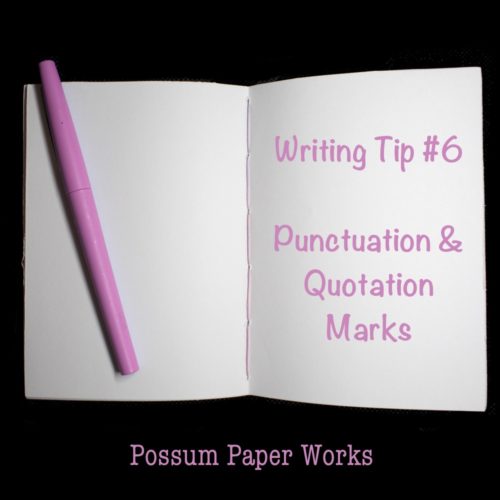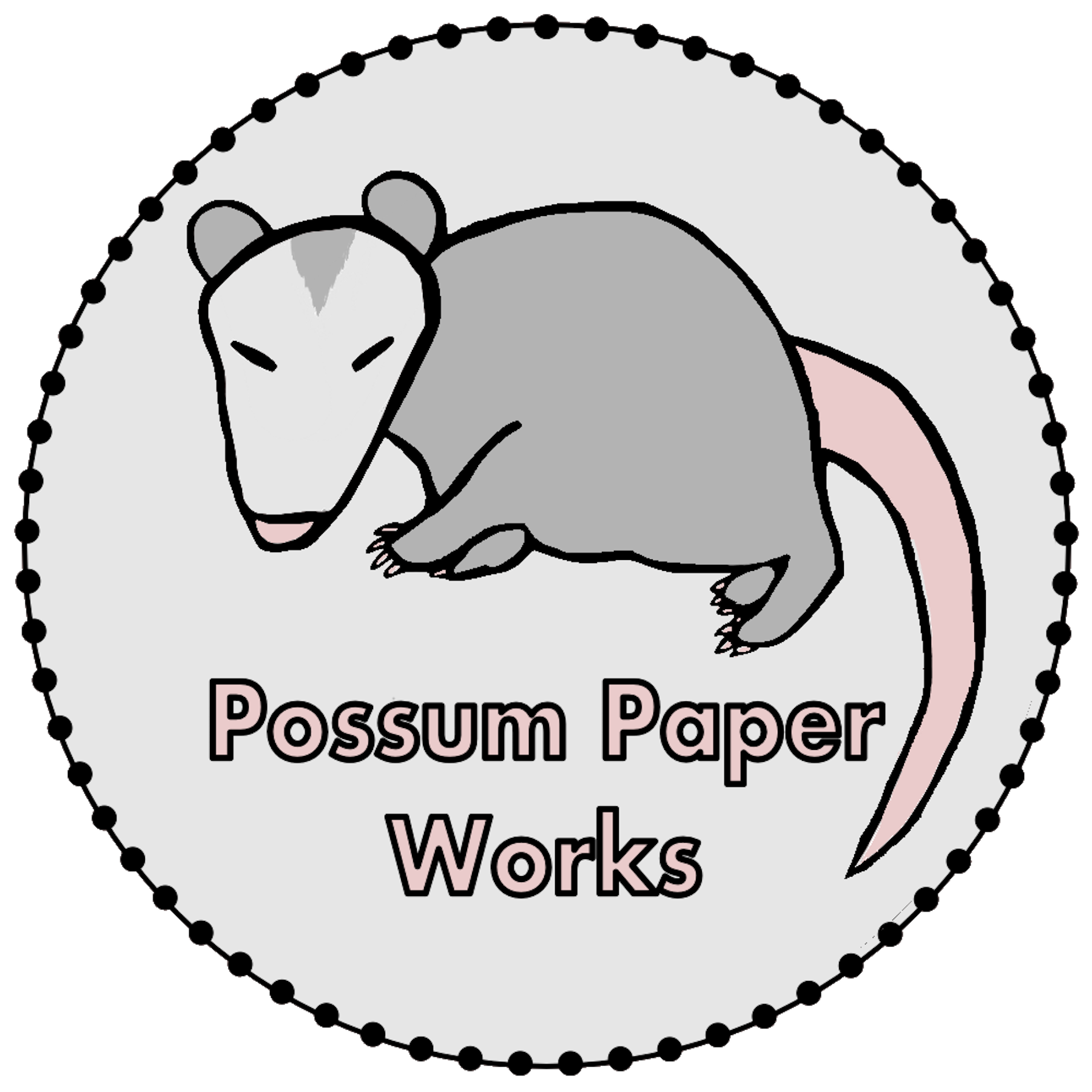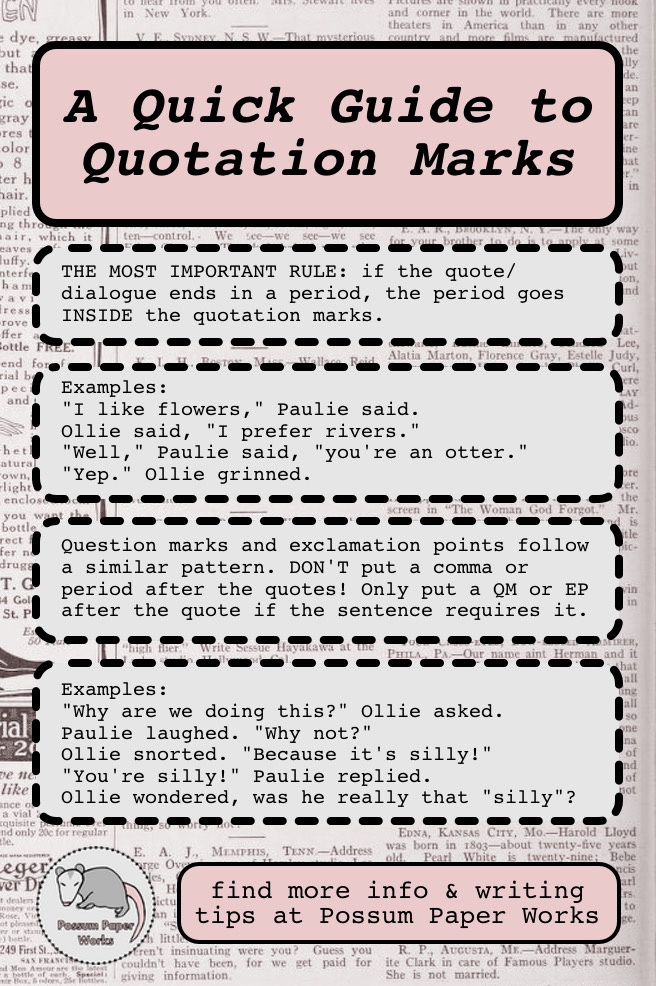
Put your hand up if you struggle with using punctuation with quotation marks in your writing. I know I put my hand up. Today’s writing tip rodeo focuses on resolving our confusion about quotes! “Yeehaw!” said Paulie the Possum.
Writing Tip #6 – Quotation Marks and Punctuation
I generally consider myself decent with grammar. The use of punctuation within quotes, though, that I struggle with. The sad part of that? Dialogue is my favorite thing to write.
It turns out, using punctuation with quotation marks isn’t that difficult. Easy to forget, maybe, but not difficult. So, to help you remember the rules, I’ve made a little guide, featuring a conversation between Paulie the Possum and Ollie the Otter!

Please note, this guide is about American English rules, not British English rules. You can find most of the rules I’m working with here and here.
A few general rules
Quotation marks only go around direct quotes. If you’re summarizing what someone said, not their exact words, don’t use quotes!
YES: This post is about “resolving our confusion about quotes.”
YES: This post talks about how to resolve your issues with quotation marks.
NO: This post discusses “how to resolve your issues with quotes.”
There’s a few other rules hidden in there: first off, notice how none of the quotes are capitalized? The quotes don’t start a new sentence–they’re actually a direct part of the sentence using the quotes. So, no capitalization needed (dialogue is a little different–see following examples).
Similarly, there are no commas just before the quotes, because the quotes function as subjects of the sentence. Again, dialogue is often a little different.
Periods
The basic rule: if it’s a period or represents a period, it goes WITHIN the quotation marks. Not outside. Not outside with a comma inside. Just INSIDE and alone.
“What do you mean by ‘represents a period’?” you may ask. Well, if a sentence continues after the quotation, use a comma instead of a period right before the second quotation mark. See the examples below for more information.
Some examples:
“I like flowers,” Paulie the Possum said.
Ollie the Otter said, “I like rivers better.”
“Well,” Paulie retorted, “you’re an otter.”
“Yep.” Ollie grinned.
In the first sentence, the end of Paulie’s words do not end the sentence. Thus, a comma is used instead of a period. And yes, the comma should be used even if it’s only a word of dialogue!
In the second sentence, the tag that tells us it’s Ollie speaking comes before his words. The sentence leads into the quote, but the quote is a separate part of the sentence, so a comma is used to show that break. Ollie’s actual dialogue ends the sentence, and thus has a period at the end, WITHIN the quotes.
The third sentence ends the same way, but the speaking tag is in the middle. Even though Paulie’s spoken sentence isn’t over, we put a comma just before the quote mark. The second part of Paulie’s line is lowercase, because he didn’t stop speaking.
The fourth sentence is actually two sentences. In the first sentence, we see only dialogue, Ollie’s line, and end the line with a period (WITHIN the quotes). The second sentence stands alone.
Also. A general dialogue rule. IF IT’S A NEW PERSON TALKING START A NEW PARAGRAPH. Please. We will all thank you.
Question Marks (and Exclamation Marks)
Question marks and exclamation points follow rules similar to periods, but without the fun challenge of replacing them with commas.
Some Examples:
“Why are we doing this?” Ollie asked, suspicious.
Paulie the Possum laughed. “Why not?”
Ollie snorted. “Because it’s silly!”
“You’re silly!” Paulie replied.
Ollie wondered , was he really that “silly”?
In the first example, Ollie asks the question, not the person writing the line (me) so the question mark goes in the quotes. The fourth example is similar, with an exclamation point instead.
DO NOT put a comma after the quote marks. Your word processor might make you want to by capitalizing the next word obnoxiously and messing up your flow if you don’t, but ignore it. Seriously.
The second and third lines show how you can use question marks and exclamation points with quotes ending the sentences – like periods, they go INSIDE the quotes. No period needed.
In the fifth example, the sentence directly asks a question. Even though the quoted word comes at the end of the sentence, the quote isn’t the question. Ollie’s thoughts are, so
On that note–I don’t using quotes with a character’s thoughts, but that’s mostly a style choice. You do you.
Other Punctuation
Unless you’re writing a formal paper or book with block quotes in it, or other longer, standalone sentences, you probably won’t need to use colons or semicolons. If you do, look it up, because different style guides might have different rules about what to do.
If you use em dashes in your dialogue, they go inside the quotes if they’re a part of the dialogue. However, if they divide the dialogue up, the dashes go outside the quotes.
Ollie grumbled, “I’m not that silly, I’m–“
“No”–Paulie laughed–“you’re otterly ridiculous.”
Although, honestly, I kinda hate how that last one looks, so I’d just use commas there, personally.
If you have any doubts, ever, look it up. Trust me, this isn’t something you want to mess up and have to fix throughout your 40,000+ word manuscript. Promise. It sucks. Now go forth and write! And don’t pay attention to Paulie, he’s just giving Ollie a hard time for the sake of theater.

